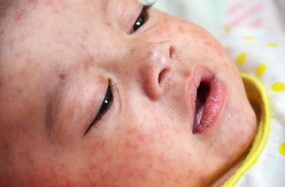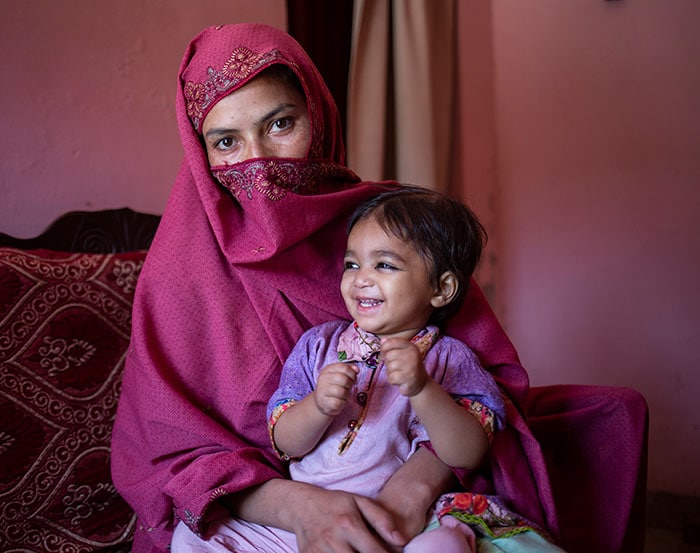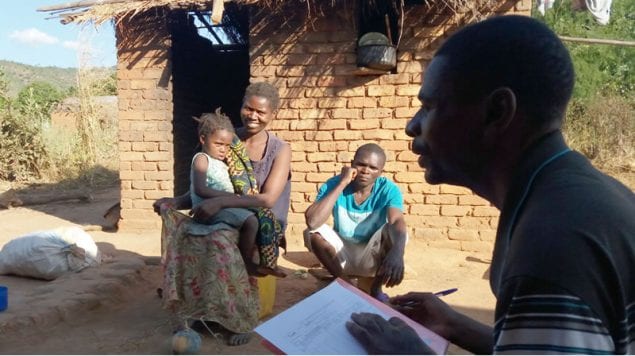Why CDC Is Involved with Global Measles & Rubella
Updated November 16, 2023
Health Cost: Measles and rubella can cause serious illness, birth defects, and death.
In 2022, measles claimed over 136,000 lives, mostly children.
Measles and rubella are diseases that can lead to serious health complications, or even death.
Children under 5 years of age are at the most risk for severe complications from measles, including pneumonia, encephalitis (brain swelling), and death. Measles can also put children at higher risk for other childhood killers – like pneumonia, diarrheal diseases and meningitis – because the virus can destroy parts of the existing immune system, lowering protection against other pathogens.

A baby with measles hospitalized in 2014, Manila, Philippines. After typhoon Haiyan, the Philippines experienced a large measles outbreak. [Photo: James Goodson/CDC]
Rubella is generally a mild disease but can have serious consequences during pregnancy. If infected with rubella virus in early pregnancy, women have up to a 90% risk of giving birth to an infant with congenital rubella syndrome (CRS).
CRS is a condition that includes multiple birth defects such as heart defects, hearing impairment, and glaucoma or cataracts. More than 100,000 children are born with CRS each year. The lifelong complications and disabilities can have an immeasurable emotional, social and financial cost for families.
Every death or disability caused by measles and rubella infection is entirely preventable.
For more information, see About Global Measles, Rubella, and Congenital Rubella Syndrome (CRS) and Fast Facts on Global Measles, Rubella, and Congenital Rubella Syndrome (CRS).
Monetary Cost: Measles and rubella cost families and countries millions annually (but are inexpensive to prevent).

A mother in Pakistan brings her young daughter to get a second dose against measles along with other routine vaccinations. ©UNICEF/U.S.CDC/UNI416497/Bashir
Measles can lead to economic losses for families, as well as place a heavy burden on local and national health systems. For example, a household in Ethiopia can lose one month’s income to care for a child sick with measles.
Responding to measles outbreaks is resource intensive and can carry high costs for health systems—in Ethiopia one outbreak response cost $758,869, or more than $70/case. Outbreak response is even more costly in places where there is little disease like the United States. In a literature review that included 10 studies on measles outbreaks from 2001 to 2018 in the U.S., researchers estimated the cost per case to range from about $7,000 to $76,000 and the total cost per outbreak ranged between nearly $10,000 to $1 million. A recent study of a 72-case measles outbreak in the U.S. estimated associated costs at $3.4 million.
Considering these real monetary costs of the diseases, preventing measles and rubella is a best buy for public health:
- Two recommended doses of measles and rubella vaccine cost less than $2 per child.
- Vaccinating against measles and rubella produces huge rewards. In fact, measles is the most cost-effective vaccine: every $1 invested in the measles vaccine yields a $58 return on investment.
Security Cost: Measles and rubella can spread from anywhere in the world.
In 2019, the United States reported the highest number of measles cases and outbreaks since before measles was eliminated in the U.S. in 2000.
Our ability to prevent infectious diseases and quickly detect and contain outbreaks where they start is a pillar of U.S. national security. We know that diseases can quickly cross borders, especially with a highly contagious respiratory disease like measles. In 2019, the United States recorded the highest number of measles cases since 1992. Measles outbreaks in New York during 2018 and 2019 lasted close to 11 months and threatened U.S. measles elimination status. These outbreaks were linked to travel between Israel, Ukraine, the United Kingdom (U.K.) and the United States.
In 2019, the United States had 25 outbreaks of measles related to imported cases from other countries.
In total, there were 92 reported importations of measles in 2019, which started 25 outbreaks in the United States. While vaccination coverage rates for measles is >90% in the United States, there are some places with unvaccinated or under-vaccinated (those who have received one dose but not the recommended two doses) people. Measles is so contagious that it can quickly spread to these at-risk and more isolated populations. CDC and global immunization partners are united in their efforts to reach all children with vaccines.
Currently, there are measles outbreaks in every region of the world, and the measles threat increases as immunity gaps grow due to COVID-19’s impacts on routine immunizations and planned vaccination campaigns worldwide. These measles outbreaks are not only a sign of poor measles vaccination coverage, but also a known early warning, or ‘tracer,’ that vital health services may not be reaching populations most at-risk.
The best protection against measles and rubella infections is to ensure that all children have access to 2-doses of measles and rubella vaccine. The ability of countries to ensure children receive both recommended doses of measles vaccine is a key indicator of global progress toward measles elimination.
CDC works globally to help strengthen immunization systems, prevent measles and rubella, mitigate and contain measles outbreaks at their source and protect Americans where they live, work, and play.

Ongoing Challenge: Too many children are missing out on the benefits of vaccines.
Measles and rubella vaccines are safe, cost-effective and improve the lives of children and communities worldwide, yet millions of children worldwide are still missing out on life-saving vaccines.
In 2022, nearly 33 million children were left at risk for measles.
Two doses of measles-containing vaccine are necessary for lifelong protection. In 2022, 22 million children missed their first dose of measles vaccine, and an additional 11 million children missed their second dose, leaving nearly 33 million children at risk. In 2021, there were nearly 40 million children left un- or under-vaccinated, the most children in over 2 decades who were left at risk. This has created dangerous conditions to allow for outbreaks to occur. Children living in low-income countries are particularly at risk, where vaccination coverage rates are lowest, and children are more likely to have severe complications.
Coordinated and collaborative action from all partners at global, regional and national levels must prioritize efforts to find and immunize all unprotected children. Measles anywhere is a threat everywhere.
Actions: CDC works worldwide to eliminate measles and rubella.
CDC works with partners worldwide to eliminate measles and rubella, protecting children from these deadly and disabling diseases. Learn more about what CDC is doing to achieve a world free from measles and rubella.